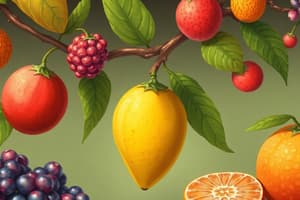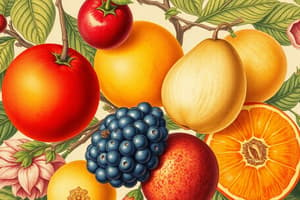Podcast
Questions and Answers
What is the primary pharmaceutical application of Cranberry?
What is the primary pharmaceutical application of Cranberry?
- Laxative
- Weight reduction
- For candidiasis (correct)
- Heart stimulant
Which fruit is known for enhancing prostate health?
Which fruit is known for enhancing prostate health?
- Persimmon
- Pineapple
- Tamarind
- Pumpkin (correct)
What is the primary use of Bromelain extracted from Pineapple?
What is the primary use of Bromelain extracted from Pineapple?
- As an antiplatelet agent (correct)
- To treat asthma
- For weight reduction
- As a laxative
Which plant is primarily used to relieve indigestion and sinusitis?
Which plant is primarily used to relieve indigestion and sinusitis?
What type of fruit is developed solely from the ovary and its contents?
What type of fruit is developed solely from the ovary and its contents?
What is a noted effect of Strychnine?
What is a noted effect of Strychnine?
Which of the following describes a dehiscent fruit?
Which of the following describes a dehiscent fruit?
What type of dry fruit is developed from several carpels?
What type of dry fruit is developed from several carpels?
What forms the hard rind in a pepo?
What forms the hard rind in a pepo?
Which type of fleshy fruit has a leathery rind?
Which type of fleshy fruit has a leathery rind?
Which part of a seed is essential for germination?
Which part of a seed is essential for germination?
How are angiosperm seeds distinguished?
How are angiosperm seeds distinguished?
Which of the following is an example of an indehiscent fruit?
Which of the following is an example of an indehiscent fruit?
What characterizes the formation of multiple fruits?
What characterizes the formation of multiple fruits?
Which component is part of a seed's structure?
Which component is part of a seed's structure?
What is the primary function of the aleurone layer in monocot seeds?
What is the primary function of the aleurone layer in monocot seeds?
Which of the following is true regarding dicot seeds?
Which of the following is true regarding dicot seeds?
What is the impact of temperature on seed germination?
What is the impact of temperature on seed germination?
Which dispersal method is most commonly associated with light seeds?
Which dispersal method is most commonly associated with light seeds?
What is the first step in the germination process of a seed?
What is the first step in the germination process of a seed?
Epigeal germination can be best described as:
Epigeal germination can be best described as:
Which statement accurately describes the role of the hilum in dicot seeds?
Which statement accurately describes the role of the hilum in dicot seeds?
Which factor does NOT affect the germination process of seeds?
Which factor does NOT affect the germination process of seeds?
Which plant is associated with improving blood flow to the retina?
Which plant is associated with improving blood flow to the retina?
Which of the following is used for atherosclerosis?
Which of the following is used for atherosclerosis?
Which plant is specifically used as a bulking laxative?
Which plant is specifically used as a bulking laxative?
What therapeutic property does Cardamom possess?
What therapeutic property does Cardamom possess?
Which plant is indicated for treating excessive thirst and sugar excretion in the urine?
Which plant is indicated for treating excessive thirst and sugar excretion in the urine?
What is a key benefit of using Borage?
What is a key benefit of using Borage?
Which of the following plants is used for mood elevation?
Which of the following plants is used for mood elevation?
Which plant is suggested for reducing skin dryness?
Which plant is suggested for reducing skin dryness?
Flashcards are hidden until you start studying
Study Notes
Fruits
- True fruit - develops from the ovary and its contents
- Accessory fruit - includes the ovary plus other floral parts, like the receptacle, petals, and sepals
- Simple fruit - forms from a single pistil
- Dry fruits - have a dry and hardened coat at maturity
- Dehiscent fruits - split open to release seeds
- Legume - formed from a single carpel and splits along both the dorsal and ventral sutures
- Follicle - formed from one carpel and splits along one suture
- Capsule - formed from several carpels
- Silique - a long and slender capsule formed from two carpels
- Indehiscent fruits - do not open at maturity to release seeds
- Achene - has a single seed attached to the fruit wall at one point
- Nut - similar to an achene but with a very thick and hardened wall
- Samara - has a wing-like outgrowth from the fruit wall
- Grain - the fruit wall and seed coat are fused
- Schizocarp - forms from several carpels
- Dehiscent fruits - split open to release seeds
- Fleshy fruits - have a soft, fleshy coat at maturity
- Drupe - one-seeded fruit from a superior ovary (e.g., peach, cherry)
- Berry - the ovary wall (or its inner portions) becomes enlarged and juicy (e.g., tomato, grape)
- Hesperidium - a type of berry with a leathery rind (e.g., orange, lemon)
- Pepo - a type of berry with a hard rind (e.g., watermelon, pumpkin)
- Pome - forms from a group of fused carpels and is surrounded by the floral tube or receptacle (e.g., apple, pear)
- Aggregate fruit - formed from multiple pistils of a single flower (e.g., raspberry, blackberry)
- Multiple fruit - formed from multiple pistils (and sometimes accessory parts) of many flowers (e.g., pineapple, fig)
Seeds
- Develop after ovules undergo fertilization
- Composed of the seed coat and embryo
- Embryo - contains the radicle (root) and cotyledons (seed leaves)
Types of Seeds
- Angiosperm seeds - enclosed within an ovary (usually within a fruit)
- Include flowers, fruits, and endosperm
- Gymnosperm seeds - not enclosed by fruit, often found on scales or leaves.
- Includes cones
Monocot Seeds
- Have a single cotyledon
- Seed coat - membranous and fused with the fruit wall ("pericarp")
- Endosperm - stores food
- Aleurone layer - proteinous layer separating the endosperm and embryo
- Scutellum - shield-shaped cotyledon
- Embryo - small and located in a groove
- Embryonal axis - has two ends: plumule (shoot tip) and radicle (root tip)
- Coleoptile - sheath enclosing the plumule
- Coleorhiza - sheath enclosing the radicle
Dicot Seeds
- Have two cotyledons
- Seed coat - outermost covering, with two layers: testa and tegmen
- Hilum - scar on the seed coat where it was attached to the fruit
- Micropyle - small pore above the hilum
- Embryo - includes the embryonal axis and two cotyledons
- Endosperm - food-storing tissue formed by double fertilization
- Cotyledons - fleshy and store food reserves
- Plumule and radicle - located at the two ends of the embryonal axis
Seed & Fruit Dispersal
- Wind - light seeds are carried by wind
- Animals - birds and ants distribute seeds
- Water - seeds with trapped air float and are dispersed by water
- Other mechanisms - cultivation by humans
Germination
- The process by which a dormant seed begins to grow into a seedling
- Some seeds require a period of dormancy before germination
- Stages of germination:
- Imbibition - seed absorbs water and swells
- Respiration - changes from anaerobic to aerobic respiration
- Effect of light - some seeds are photoblastic (need light) or non-photoblastic (light has no effect)
- Mobilization of reserves - stored starch, protein, or fats are utilized
- Development of the embryo axis - cells grow and divide to form a seedling
Modes of Germination
- Epigeal germination - the cotyledons emerge above the soil
- Hypogeal germination - the cotyledons remain below the soil
Factors Affecting Germination
- Internal factors
- Embryo maturity
- Presence or absence of chemical inhibitors
- External factors
- Oxygen
- Water
- Temperature (optimal range: 5 to 40°C)
### Pharmaceutical and Pharmacological Importance of Fruits and Seeds
- Fruits
- Angelica (A. archangelica) - treats cold and fever
- Buckthorn (Rhamnus catharticus) - laxative
- Cranberry (Vaccinium oxycoccum) - treats candidiasis
- Cubeb (Piper cubeba) - condiment; treats asthma
- Mangosteen (Garcinia mangostana) - aids in weight reduction
- Persimmon (Diospyros virginiana) - astringent, high in beta-carotene and vitamin C
- Spicebush (Lindera benzoin) - reduces fever when brewed as a tea
- Tamarind (Tamarindus indica) - laxative
- Pineapple (Ananas comosus) - contains bromelain (antiplatelet, improves circulation, treats mouth ulcers)
- Seeds
- Anise (Pimpinella anisum) - relieves indigestion and sinusitis
- Velvet bean (Mucuna spp.) - treats Parkinson’s disease
- Strophanthus (Strophanthus spp.) - source of cortisone; heart stimulant
- Strychnine (Strychnos nox-vomica) - stimulates CNS and relieves paralysis
- Pumpkin (Cucurbita pepo) - promotes prostate health
- Oats (Avena sativa) - enhances physical and sexual health
- Perilla (P. frustescens) - rich in omega-3 fatty acids for cardiac health
- Evening primrose (Oenothera spp.) - source of gamma-linolenic acid
- Fenugreek (Trigonella foenum-grecum) - bulking laxative, treats mucus, asthma, and skin inflammation
- Flax (Linum usitatissimum) - treats atherosclerosis; laxative and for bronchial problems
- Grape (Vitis vinifera) - antioxidant, improves blood flow to the retina
- Grapefruit (Citrus paradise) - treats bacterial and fungal infections
- Horse chestnut (Aesculus hippocastanum) - improves blood flow, reduces varicose veins and leg swelling
- Java plum (Syzygium cumini) - treats excessive thirst and excretion of sugar in urine
- Apricot (Prunus armeniaca) - bronchodilator
- Black currant (Ribes nigrum) - improves skin and reduces dryness
- Cardamom (Elettaria cardamomum) - has antibiotic properties and treats colds
- Celery (Apium graveolens) - antioxidant, sedative properties
- Borage (Borago officinalis) - contains gamma-linolenic acid (GLA)
- Chaulmoogra (Hydnocarpus spp.) - treats eczema, psoriasis, and leprosy
- Chia (Salvia columbariae) - enhances endurance and treats eye irritation
- Chocolate (Theobroma cacao) - elevates serotonin, improves mood
- Cola (C. nitida/ acuminate) - lessens fatigue (contains caffeine and theobromine)
Studying That Suits You
Use AI to generate personalized quizzes and flashcards to suit your learning preferences.




